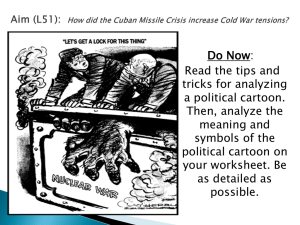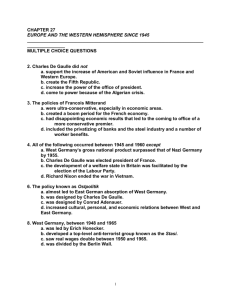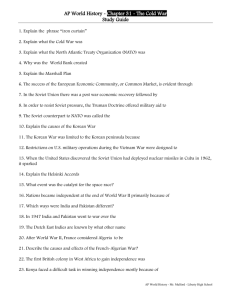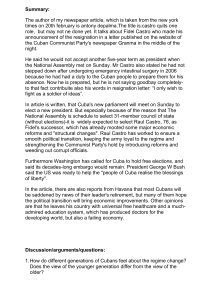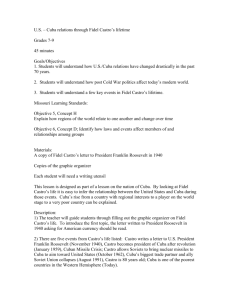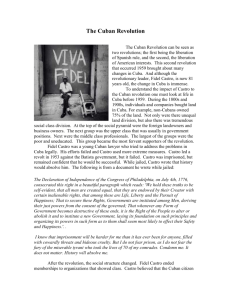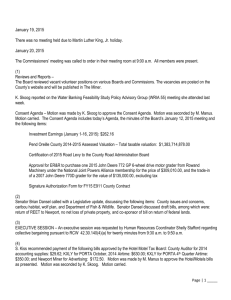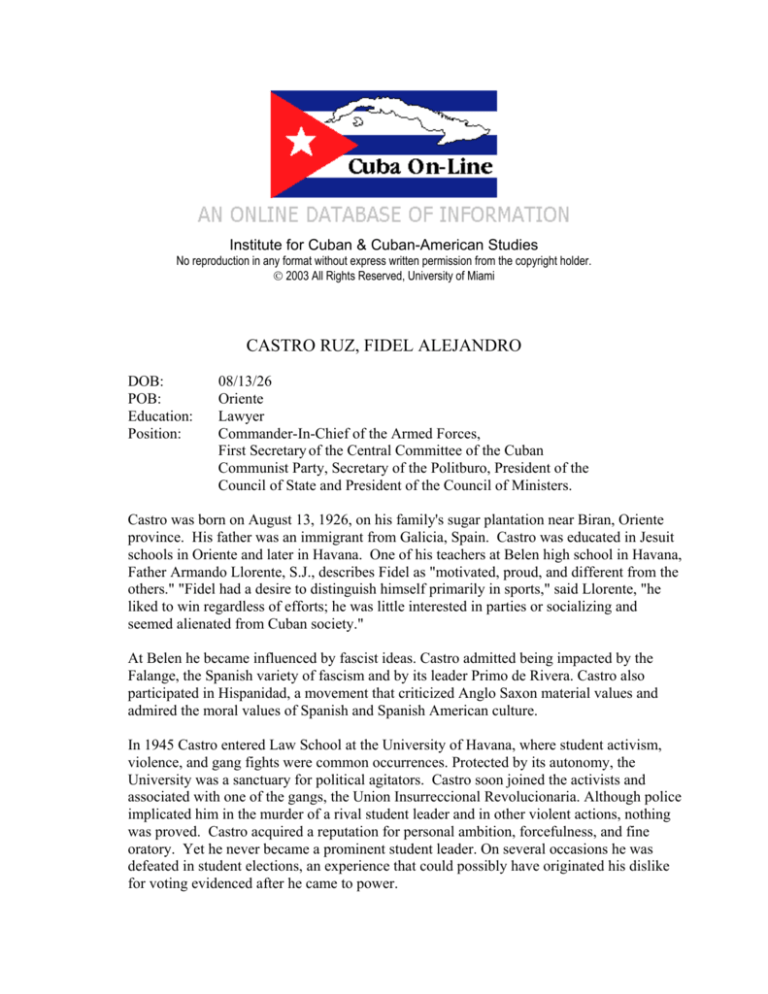
Institute for Cuban & Cuban-American Studies
No reproduction in any format without express written permission from the copyright holder.
2003 All Rights Reserved, University of Miami
CASTRO RUZ, FIDEL ALEJANDRO
DOB:
POB:
Education:
Position:
08/13/26
Oriente
Lawyer
Commander-In-Chief of the Armed Forces,
First Secretary of the Central Committee of the Cuban
Communist Party, Secretary of the Politburo, President of the
Council of State and President of the Council of Ministers.
Castro was born on August 13, 1926, on his family's sugar plantation near Biran, Oriente
province. His father was an immigrant from Galicia, Spain. Castro was educated in Jesuit
schools in Oriente and later in Havana. One of his teachers at Belen high school in Havana,
Father Armando Llorente, S.J., describes Fidel as "motivated, proud, and different from the
others." "Fidel had a desire to distinguish himself primarily in sports," said Llorente, "he
liked to win regardless of efforts; he was little interested in parties or socializing and
seemed alienated from Cuban society."
At Belen he became influenced by fascist ideas. Castro admitted being impacted by the
Falange, the Spanish variety of fascism and by its leader Primo de Rivera. Castro also
participated in Hispanidad, a movement that criticized Anglo Saxon material values and
admired the moral values of Spanish and Spanish American culture.
In 1945 Castro entered Law School at the University of Havana, where student activism,
violence, and gang fights were common occurrences. Protected by its autonomy, the
University was a sanctuary for political agitators. Castro soon joined the activists and
associated with one of the gangs, the Union Insurreccional Revolucionaria. Although police
implicated him in the murder of a rival student leader and in other violent actions, nothing
was proved. Castro acquired a reputation for personal ambition, forcefulness, and fine
oratory. Yet he never became a prominent student leader. On several occasions he was
defeated in student elections, an experience that could possibly have originated his dislike
for voting evidenced after he came to power.
In 1947 Castro left the University temporarily to enroll in an attempt to overthrow
Dominican Dictator Rafael L. Trujillo. He trained in military tactics and the use of weapons
in a small island of Cuba’s shores. The expedition never materialized. In 1948 he
participated in one of the most controversial episodes of his life, the "Bogotazo" --a series
of riots in Bogotá following the assassination of Liberal Party leader Jorge E. Gaitan.
At the time, Argentine Dictator Juan D. Peron, who favored the establishment of an antiimperialist Latin American Student Union under his control, encouraged four Cuban
students, including Castro, to attend a student meeting in Bogotá. The gathering was timed
to coincide with the Ninth Inter-American Conference that Peron opposed, and which the
Communists were also bent on disrupting. When the Colombian leader Jorge E. Gaitan was
assassinated, riots and chaos followed. Castro was caught up in the violence that rocked
Colombian society. Picking up a rifle from a police station, he joined the mobs and roamed
the streets distributing anti-U.S. propaganda and inciting the populace to revolt. One of
Castro's student companions denies that Castro was a Communist. "It was," claimed
Enrique Ovares, "a hysteric, ambitious, and uncontrollable Fidel who acted in these events."
Pursued by Colombian police, he and the other students went to the Cuban Embassy and
were later flown back to Havana where Castro resumed his studies.
At the University, Castro was exposed to different ideologies. On the campus, more than
anywhere else, the nation's problems were constantly debated. Theories of all sorts
flourished vigorously. The authoritarian ideas of fascism and communism were widely
discussed. But above all, the nationalistic program of Cuba's Partido Ortodoxo – economic
independence, political liberty, social justice, and an end to corruption – captured the
imagination of the students. The party's charismatic leader, Eduardo Chibas, became their
idol. Castro developed into a devoted follower of Chibas, absorbing the latter's somewhat
vague but puritanical ideology. He also married Mirta Diaz-Balart, a young philosophy
student with whom he had one son. The marriage later broke up. In 1950 Castro graduated
and began practicing law in Havana. Law soon gave way to politics and revolution. Castro
became a Congressional candidate on the Orthodox party slate for the June 1952 election.
The election, however, was never held. On March 10, 1952, Fulgencio Batista and a group
of army conspirators overthrew President Carlos Prio's regime. For Castro violence seemed
the only way to oppose the military coup. He organized a group of followers and, on July
26, 1953, attacked the Moncada military barracks in Orient province. Castro was captured,
tried, and sentenced to 15 years in prison. Castro defended himself in the trial in a speech
attacking Batista's regime and outlining his political and economic ideas, most of them
within the mainstream of Cuba's political tradition.
After being released by an amnesty in 1955, the untiring and determined Castro traveled to
Mexico and began organizing an expedition against Batista. On December 2, 1956, Fidel,
his brother Raul, and 80 men landed in Oriente province. After encounters with the army in
which all but 12 of the expeditionaries were killed or captured, Castro fled to the Sierra
Maestra mountains forming there a nucleus for a guerrilla operation. At the same time,
urban opposition to the Batista regime increased. While Castro was in the mountains, an
attack on the Presidential Palace on March 13, 1957, led by students and followers of
deposed President Prio, nearly succeeded in killing Batista. On April 9, 1958, Castro called
an unsuccessful national strike.
The government met terrorism with counter-terrorism. Political opponents were tortured
and assassinated. By 1958 a movement of national revulsion against Batista had developed.
Castro emerged as the undisputed leader of the anti-Batista opposition and his guerrillas
increased their control over rural areas. Finally defections in the army precipitated the
crumbling of the regime on December 31, 1958. On January 1, 1959 Castro and his July
26th Movement assumed power. Castro proclaimed a provisional government and began
public trials and executions of "criminals" of the Batista regime. On February 15, Castro
appointed his brother commander of the armed forces.
A powerful speaker and a charismatic leader, Castro exerted an almost mystical hold over
the Cuban masses. As Marti had done three quarters of a century earlier and Chibas only a
decade before, Castro lectured the Cubans on morality and public virtue. He emphasized
his commitment to democracy and social reform, promising to hold free elections. Denying
that he was a Communist, he described his revolution as being humanistic and promised a
nationalistic government, which would respect private property and Cuba's international
obligations. Attempting to consolidate his support inside Cuba, Castro introduced several
reforms. First, he confiscated wealth "illegally" acquired by Batista's followers. Then, he
substantially reduced rents paid by tenants of houses and apartments. Finally, he passed an
agrarian reform law that confiscated landed property. Although the avowed purpose of this
law was to develop a class of independent farmers, in reality the regime transformed the
areas seized into cooperatives managed by a National Institute of Agrarian Reform As time
went by, cooperatives gave way to state farms, with farmers becoming government
employees. Toward the end of 1959 a radicalization of the revolution took place. This was
accompanied by the defection or purge of revolutionary leaders and their replacement by
more radical and oftentimes Communist militants. Castro accused the United States of
harboring aggressive designs against the revolution. In February 1960, Anastas Mikoyan,
Deputy Premier of the Soviet Union, visited Havana and signed a Cuban-Soviet trade
agreement, and soon after Cuba established diplomatic relations with the Soviet Union and
most Communist countries. Castro's verbal attacks against the United States increased.
Several months later, when the three largest American oil refineries in Cuba refused to
refine Soviet petroleum, Castro confiscated them. The United States retaliated by cutting
Cuba's sugar quota. Castro in turn confiscated, without payment, American properties as
well as many Cuban businesses. In September 1960 Castro attended the United Nations
General Assembly in New York, exchanging embraces with Soviet Premier Nikita
Khrushchev. In January 1961 President Eisenhower broke relations with Cuba. By that
time anti-Castro exiles, supported by the United States, were training for an invasion of the
island. The failure of the Bay of Pigs invasion in April 1961 consolidated Castro's power
and eventually led to the introduction of Soviet nuclear missiles in Cuba and to the October
1962 missile crisis. After the invasion, Castro declared his regime to be socialist, economic
centralization and repression increased. Private schools fell under government control. This
was accompanied by a nation-wide literacy campaign and by an increase of educational
facilities. Sanitation and health improved with the establishment of rural hospitals under
state control. Religious institutions were suppressed and clergymen expelled from the
island. Thousands of Cubans fled the island. In December 1961, Castro openly espoused
Communism. "I am a Marxist- Leninist," he said, "and shall be one until the end of my
life." Castro also organized a single party to rule Cuba. By the middle of 1961, he merged
all groups that had fought against Batista into the Integrated Revolutionary Organizations, a
preparatory step toward the creation later of the United Party of the Socialist Revolution,
transformed in 1965 into the Communist Party of Cuba --the island's present and only ruling
party.
In foreign affairs Castro moved closer to the Soviet Union. The October 1962 missile crisis,
however, strained Cuban-Soviet relations. By negotiating directly with the U.S., the Soviets
humiliated Castro. Despite Castro's two visits to the Soviet Union, in April 1963 and
January 1964 and increased Soviet aid, uneasy relations prevailed between Havana and
Moscow. At the same time, pro-Soviet Cuban communists were eliminated from positions
of power. Until the end of 1963 Castro attempted to maintain a position of neutrality in the
Sino-Soviet dispute. But following the 1964 Havana Conference of pro- Soviet Latin
American Communist parties, the Soviet Union pressured Castro into supporting its
policies. Cuba's relations with China deteriorated, and early in 1966 Castro denounced the
Chinese regime. By supporting the Soviet invasion of Czechoslovakia in 1968 Castro
demonstrated his dependence on the Soviet Union as well as his determination to move
closer to the Soviet camp. Another source of conflict in Cuban-Soviet relations was
Castro's determination to export his revolution. After the 1964 Havana Conference of Latin
American Communist parties, the Soviet Union was temporarily able to slow down Castro's
support for armed struggle in Latin America. But by 1966 Castro founded in Havana the
Asia-Africa-Latin America People's Solidarity Organization (AALAPSO) to promote
revolution in three continents. In July 1967 he formed the Latin American Solidarity
Organization (OLAS), specifically designed to impel violence in Latin America. Castro's
efforts in the 1960s were unsuccessful, as evidenced by the failure of Ernesto "Che"
Guevara's guerrilla campaign in Bolivia and his death in 1967. Yet in the 1970s he could
claim that the Nicaraguan revolution vindicated his commitment to violence as the
Sandinistas overthrew the Somoza dictatorship. Also Cuba, with Soviet support, dispatched
thousands of Cuban troops to Angola to establish a pro-Soviet Marxist regime. Castro was
elected Chairman of the non-aligned movement and visited various African countries.
Castro also supported the Allende regime in Chile sending numerous Cuban security
personnel to boost the Marxist regime and provided money, weapons and personnel to the
guerrillas in El Salvador, Colombia and Guatemala in attempts to establish communist
regimes in those countries. Castro also supported terrorist organizations in the Middle East
establishing close cooperation with the PLO, Hammas and others. He aligned himself with
the most radical, anti-American regimes such as Syria, India, Libya and North Korea.
After the collapse of the Soviet Union and Communism in Eastern Europe, Castro toned
down his support for guerillas and violence. Yet he continued to support the FARC in
Colombia and other groups in the Middle East. The Hugo Chavez electoral victory in
Venezuela provided Castro with a friend and close ally. Cuban security personnel where
dispatched to Venezuela to train and support Chavez’ security apparatus.
For more than four decades now Castro has led the Cuban Revolution. Supervising
projects, making decisions, traveling constantly, Castro has conducted his government in a
highly personal style, exercising totalitarian control. A vague ideologist himself, he
transformed the island into a Communist State aligned with the worst enemies of the United
States. He defied the United States' power and brought the world to the brink of a nuclear
holocaust. A determined revolutionary, he has made the shock waves of the Cuban
Revolution felt not only in Latin America but also throughout the world. Despite economic
difficulties after the end of the Soviet era, he has maintained tight political control by
clamping down on enemies and by allowing potential foes to leave the island. A hero to
some, a traitor to others, a criminal demagogue to still others, Fidel Castro is undoubtedly
one of these decades' most controversial political leaders.


